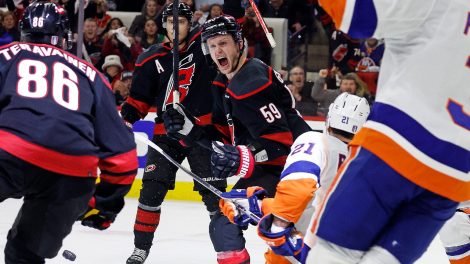CHICAGO — It’s two-and-half hours before Game 2 of the Western Conference Final. The Anaheim coaches are holding their usual pre-game breakdown. The video coach is working the laptop, and Bruce Boudreau is ticking off the key points to beating Chicago.
Teaching time has passed. This is more about reminders, and there is one reminder that has echoed through National Hockey League dressing rooms for years now, particularly come playoff time. “No. 2? Get the puck in behind him and pound him. Pound him. Don’t pass up a chance to put the body on him.”
STANLEY CUP PLAYOFFS: | Broadcast Schedule
Rogers NHL GameCentre LIVE | Stanley Cup Playoffs Fantasy Hockey
New Sportsnet app: iTunes | Google Play
Of course, No. 2 is Duncan Keith, the Blackhawks defenceman who has averaged a league high 32:02 of ice time per playoff game this spring, while leading all defencemen with 11 points. He has become, before our eyes, a generational pointman, arguably the very best all-around blueliner in the game today.
“Pound him!”
Nobody wants to injure Keith. That isn’t how hockey works at this level.
The orders are simply to hit Keith as hard and as often as possible. And if that results in Keith playing a little skittish, missing a few shifts, or even a game or two, well, that’s called helping your team win, isn’t it?
“I’ve been dodging checks my whole life,” shrugs Keith, who scored 51 goals in his last season of Midget hockey in Penticton B.C. “It’s not anything different now.”
In the NHL’s post-rodeo era, where the cry “Get a stick on him!” is no longer heard from coaches as the opponent carries the puck through the neutral zone, going back to retrieve a properly deposited dump-in has become a far more dangerous exercise.
Where yesterday your partner could “hold up” a charging forechecker with his stick or body position, today they call that hooking or interference. Goalie travel is restricted, so quite often the guardian simply must stand in his crease and watch as his D-man gets crushed by the forechecker.
“I’m six feet now, but I’ve always been a guy who is under-sized,” Keith says, still sweating long after practice, in an open shirt and sports coat. “Guys are fast, skilled, and that’s part of the reason why I’ve tried to work on my quickness. So I can outrace guys in those situations.”
It’s an art he has mastered.
In Game 1 Anaheim was credited with 44 hits. Keith played 28:25 that night, yet was only noted as the victim of two of those hits. In Game 2, a triple overtime affair, Keith played a game high 49:51. He took 60 shifts, but was not noted as being hit until 3:27 of the third period, when Ryan Getzlaf put a lick on him.
No Blackhawk possesses the puck more than Keith, yet in those 60 shifts the Ducks caught him a total of four times on the night.
Goaltender Corey Crawford has a front row seat to Keith’s magnificent defensive work. He admits, “He makes it look so easy, that people don’t even notice. Sometimes you kind of get used to that level.”
Keith’s survival in the defensive end allows for his dominance at the offensive blueline, and there may not be words to describe the level of poise required to handle a bouncing pass on terrible ice when you’re the last man back in double overtime. Yet, Keith routinely makes the right play with Sergei Zubov-like skill, Scott Niedermayer-like patience, and Nick Lidstrom-like consistency.
Will history record Keith alongside those names? Maybe, maybe not. But in a game that is increasingly faster than the one those men played, with far less protection, Keith does many of the things they did, every bit as well.
“He’s so fast,” marvels Crawford. “The first couple strides, I don’t know if there’s a guy faster than him. He gets away.”
There are no Bobby Orrs or Paul Coffeys anymore. The end-to-end rush has been coached out of the game, with neutral zones more convoluted than a Tom Brady explanation.
Today’s defenceman is about the “first pass” — about “getting it and moving it” — and as such, the great defencemen possess skills that are subtler than Orr. It’s about repeatability today, and doing it at both ends. It is where, for my money, Keith and Drew Doughty become more valuable than, say, an Erik Karlsson, whose greatness is more concentrated in the offensive zone. The best defencemen today protect a lead as ably as they acquire it.
And they play half a game now, a minor miracle in a time when a 50-second shift is considered too long by most coaches.
“Growing up, I never knew what the ice times were. We didn’t have stats like that in junior,” he said. “I remember growing up in Fort Frances, Ontario, we only had four D on our team the one year. So I played a lot.”
Keith is 31, and is 766 games and two Norris Trophies into a Hall of Fame career. He is the engine that drives what qualifies as a dynasty these days, the Chicago Blackhawks of this century’s second decade.
“He’s one of our most important players,” nods Patrick Kane. “We all know that in here.”









